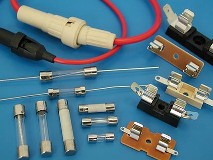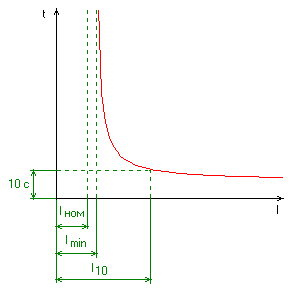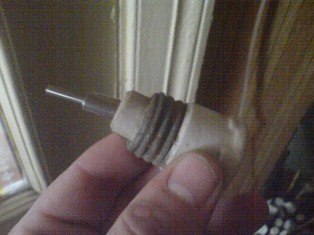Categories: Novice electricians, About electricians and not only
Number of views: 72503
Comments on the article: 0
About electrical protection devices for "dummies": fuses
 Fuses are designed to protect electrical networks from overloads and short circuits. They are very cheap and elementary simple in design. These devices are rightfully considered pioneers of circuit protection.
Fuses are designed to protect electrical networks from overloads and short circuits. They are very cheap and elementary simple in design. These devices are rightfully considered pioneers of circuit protection.
The fuse consists of two main parts: the casing is made of electrical insulating material (glass, ceramics) and the fuse (wire, metal strips). The outputs of the fuse-link are connected to the terminals, with the help of which the fuse is connected in series with the protected consumer or the circuit section. To do this, use special terminal holders. They must ensure reliable contact of the fuse - otherwise heating is possible in this place.
The fusible insert is selected so that it melts before the temperature of the line wires reaches a dangerous level or an overloaded consumer fails.
By design features distinguish between plate, cartridge, tube and plug fuses. The current strength for which the fuse is designed is indicated on its body. The maximum permissible voltage at which a fuse can be used is also specified.
The main characteristic of the fusible insert is the dependence of the time of its burnout on the current. This dependency is the following graph:

This curve is taken experimentally: a batch of identical fuses is taken, which are sequentially burned at different currents. The time after which the insert burns out and the current passing through the insert are measured. Each current corresponds to a specific burnout time of the insert. According to these data, a temporary characteristic is built.
The following currents are especially highlighted in the graph that are used to select fusible inserts: Imin is the smallest of the currents that melt the insert (at this current, the insert still melts, but for an indefinitely long time (1-2 hours); at lower currents, the insert no longer melts);
I10 - current at which the insert is melted and the network is disconnected 10 s after the current is established; Inom is the rated current of the insert, i.e. current at which the insert works for a long time without heating above the permissible temperature.
The currents are connected by a simple ratio Inom = I10 / 2.5.
Probably all of us have seen ceramic "corks" that are wrapped in the shield of an electric meter. Until recently, and sometimes even now, they still serve as protection devices. From personal experience - I have repeatedly encountered such a switching circuit - there are two plugs in the shield, one is in the phase wire, the second is in the zero. But what a wiring diagram is categorically wrong! In no case should you include a fuse in the neutral wire. After all, what happens if it fails - the circuit will develop and be protected, but consumers will still be under the potential of the network - there is a phase. And these are questions of electrical safety.
Once, when replacing the electric meter, I happened to observe an interesting picture. Instead of a fusible insert, something incomprehensible was inserted into the ceramic cork. When I realized that it was, I could not resist, so as not to photograph this "protection device" in memory:

Can you imagine how this “fuse” protects the wiring? Moreover, the wiring was in the 60s. How it all could end, I think, is not worth explaining. So if you already put a “bug” (this, by the way, is forbidden) instead of the standard fuse, select the wire cross section in accordance with the table that I mentioned above.
Despite the fact that fuses have served their time and are outdated as protection devices in the inputs of the household sector, throughout the entire time of their existence they adequately performed this function.
Fuses, of course, cope with their protection functions against overcurrent or short circuit. However, today, especially in the domestic sector, fuses are becoming a rarity. Plus, these are quite dangerous firefighting devices. Indeed, today many consider themselves to be electricians, and when the “plug” burns out, some “specialists” install “bugs” from uncalibrated wire. Moreover, sometimes, quite exotic. I described a typical example in a previous review. And what is all this fraught with - you don’t have to go far - look at the chronicle of an emergency on any TV channel. Therefore, it is quite natural that fusible inserts were replaced by more reliable devices - circuit breakers.
Mikhail Tikhonchuk
Continuation of the article: About electrical protection devices for dummies: circuit breakers
See also at i.electricianexp.com
:
